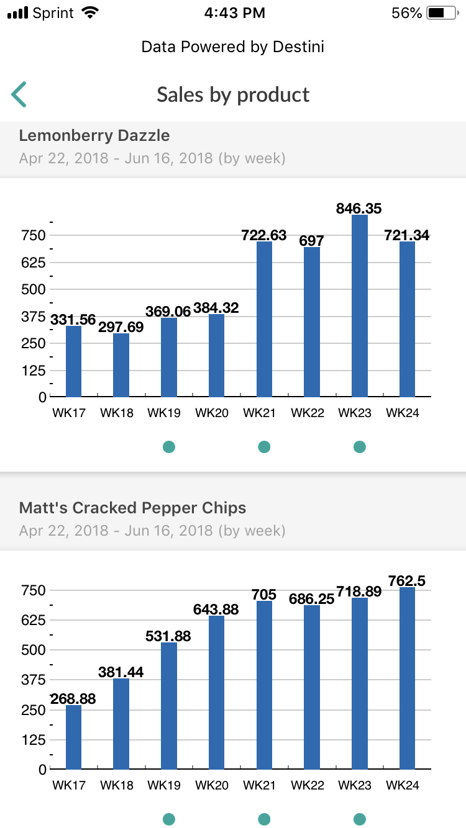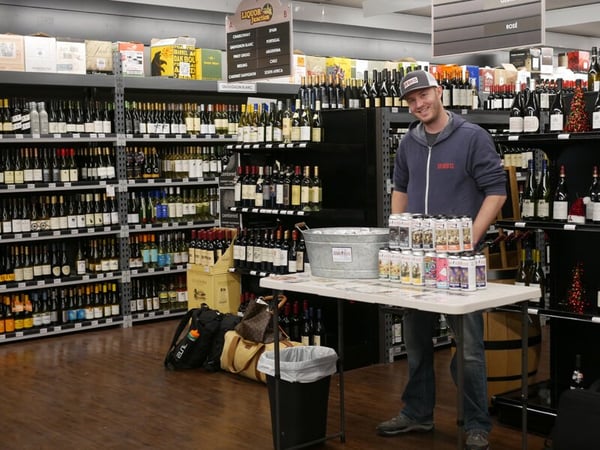It’s not easy to approach a retailer and explain to them why they should give you more facings, or if you're new, why they should take on your brand at all. You have to be equipped with a compelling story that positions your brand as an investment that'll help the retailer move product off the shelf.
When talking to store managers who hear dozens of pitches a week, there's one clear way to cut through the noise -- come equipped with the data you need to make your case.
In this post, we'll walk through six ways your team can use data to grow your retail footprint, in both new and existing accounts.
Why Is Data Important to Retailers?
When you’re talking about cold, hard data with a retailer you’re speaking their language. Because retailers have so many brands to think about on a daily basis, chances are they aren’t going to go out of their way to give you an extra end cap just because they like the newest iteration of your packaging design. They might think about it, however, if your packaging change has boosted your sales 10% in the last month in their closest three competitors’ stores. Because retailers are looking at CPG brands in a more critical light than in years past, you’ll need to come prepared with the facts in order to be taken seriously.
Data is important to retailers because, at the end of the day, the numbers dictate who will be able to last long-term on their shelves and bring in a profit at the end of the quarter. A McKinsey study on North American CPG companies shows the leaps and bounds brands have made with data using online retailers -- and these results are replicated in their brick-and-mortar siblings. If the data shows your brand bringing in big bucks because it received 2 more placements in the store, chances are your wish for expansion will be granted a lot faster than it would have if you had made the pitch based exclusively on your intuition.
Selling Into a New Chain?
Data is a great ice breaker. Even if your brand has a variety of placements with other retailers, each new retailer pitch is an opportunity to step up your game and improve growth even further. By using sales, observational, and activity data, the retailer can get a panoramic view of your brand.
1. Show Off Your Track Record
In the same way that employment history is a critical element on a resume when someone is hoping to be hired by a new company, proof that your brand has a historically strong sales performance is critical in a first encounter with a new retailer. Coming into a buyer meeting with concrete sales data demonstrates that you’ve done your research and you’re serious about getting your foot in the door.
Talking point: The number of units sold at a similar retail location last month
NYX brand cosmetics are sold at a variety of retailers, like Target and Sephora (shown above). If NYX can demonstrate that their sales are increasing in one location, they’ll be more likely to be offered more placements at a similar retailer.
Sales data accounts for how many units of a given SKU were sold over a certain period of time. Showing a retailer the number of units of your product that sold at a competing retailer, or, even more to the point, providing them with your revenue at similar stores, demonstrates your retail potential for their location and provides incentive for the retailer to take you on in the future.
2. Share Your Formula for Success
Your conversation shouldn’t be one-sided -- be up front about your expectations regarding how many placements and facings you hope to have in their location so that the retailer knows what to expect right off the bat.
Talking point: If any of your competitors are available in this location, talk about your displays in those stores
This photo demonstrates a display of dish soaps from a variety of brands. A dish soap brand hoping to gain facings could gain valuable observational data to share with retailers from this display.
Observed data, such as how many facings you usually have in similar stores and what the placements of your competitors look like, will give your retailers an idea of what type of setup is most effective for your product.
3. Show What You Bring to the Category
Beyond proving that your brand is a good fit for a particular location, show the retailer that your product will improve their store overall to draw them in all the way.
Talking point: Get them excited about any demos or tastings you hold and the amount of traffic that those events will bring into their store
Activity data, such as information gathered during an in-store event, is important to retailers. If your events are successful and engage customers, this customer flow benefits the retailer and your brand simultaneously. By demonstrating these benefits through data, a retailer can gauge your value on a level even beyond your monthly revenue.
Seeking New Facings in an Existing Account?
Even if a retailer is already carrying your brand, data can be leveraged to increase average order size for your account, or simply to increase the number of placements or facings within the store. The number one way to motivate a retailer to make these changes in your favor is to demonstrate your growth during the time you’ve had a presence in their store.
4. Highlight Growth Patterns
Seniority doesn’t always mean superiority. Even if you’ve been with a specific retailer for a few years, if the store perceives your sales are stagnant you probably won't get the boost in facings you were hoping for. This being said, there are ways out of this frustrating cycle. If you can demonstrate that your product increased in revenue, your requests might very well be granted.
Talking point: Discuss increases in revenue over the duration of your presence in their location
Using sales data to justify requests for facings increases makes sense, especially if your order size has already increased in similar locations. If your retailer can see that an increase in facings has resulted in an increase in overall revenue for other stores, they’ll be more likely to take the plunge so they can also reap the benefits.

This graph, presenting some product revenue data pulled from Destini, would be a perfect piece of data to use in a conversation with a retailer if you’re trying to demonstrate the growth of your brand over time to gain new facings.
5. Show Evidence of Demand
No one knows your product better than your team. If your reps have been taking note of patterns with out of stock items and overall customer responses to new products while in the store, it isn’t hard to determine which products customers wish they could have more access to -- now you just have to prove it to your retailer.
Talking point: Keep a close eye on your products in the store and talk to the retailers about any positive trends
Observed data, like repeated and unusually frequent out of stocks, will dictate to retailers that your product is successful. If they aren’t able to keep it on the shelves due to high demand, chances are you’ve got a good shot at increasing your placings.
6. Tie Your Growth to the Store's Success
If you’re expecting an increase in sales, your retailer can likely expect an increase in store traffic as well. More people walking through the retailer’s door is good news on their end, so being able to prove that this traffic will be generated is an effective way to build support and increase the likelihood that a retailer will increase your presence within their store.
Talking point: If you’re planning an event or running a new promotion, give your retailer an estimate of the store’s increased traffic based on any activity data your team collected during a similar event in the past

Even though activity data from a previous event might not reflect the exact increase in revenue a retailer can expect from an event you plan, if you’re looking for an increase in store placements it won’t hurt to tip a retailer off to the notion that you’ll be playing a part in boosting their overall traffic sometime soon.
When you’re talking to a retailer, use data to prove that you’ve done your research and know how to make the biggest impact in their store. It's one thing to tell a retailer that your product is drawing new customers and needs a larger presence, but it's a completely new thing to demonstrate to them the validity of your claim using data from three angles: observation, sales, and activity. Using these strategies will give you the upper hand with a retailer -- regardless of whether you’re trying to gain your first foothold in a new location or simply increase your presence within an established location.






